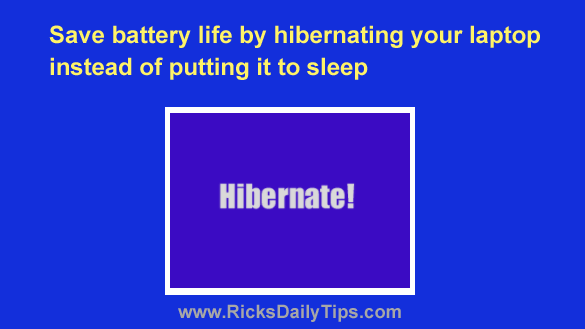 Like many laptop owners, you probably put your machine into sleep mode every time you shut the lid to transport it to a new location.
Like many laptop owners, you probably put your machine into sleep mode every time you shut the lid to transport it to a new location.
But if you constantly find yourself having to deal with a low battery, there is a better way. Hibernate your laptop instead!
Sleep mode has its place, and that is when you’re going to be away from the laptop for a short while (i.e. when you’re on lunch break).
Hibernating the machine instead during longer breaks in usage (a day or two, for instance) can make your laptop’s battery charge last longer.
The reason is simple: When you place a PC into sleep mode it goes into a low power state during which all of your open programs and data are kept “alive” in RAM.
While it’s true that a laptop in sleep mode “sips” juice from the battery instead of guzzling it, this “sipping” can still drain much of a battery’s charge over the course of even a few hours in some models.
Hibernation on the other hand copies the contents of RAM (the current state of the system) onto the hard drive and completely shuts down the laptop. And when a laptop is shut down, it draws virtually no power from the battery.
The only real downside of hibernation is it takes longer to boot the laptop back up into its previous state so you can get back to work.
Yes, that’s a trade-off that does need to be considered, but I’ve discovered over the years that a few extra seconds of boot time is a small price to pay in exchange for longer battery life.
Note 1: Depending on your PC’s power settings, you might find that the Hibernate option is currently disabled. If so, you can enable it quite easily by following the instructions on this Microsoft Support page.
2 – The option to enable hibernation isn’t available on a small number of desktop PC models. If you don’t see that option listed in the settings that’s means it isn’t available on your particular model.